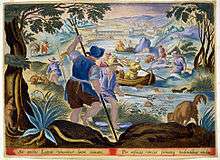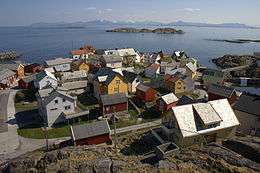Port Isaac
Port Isaac (Cornish: Porthysek)[1] is a small fishing village[2] on the Atlantic coast of north Cornwall, England, United Kingdom. The nearest towns are Wadebridge and Camelford, both ten miles away. Port Gaverne, commonly mistaken to be part of Port Isaac, is a nearby hamlet that has its own history. The meaning of the Cornish name is "corn port", indicating a trade in corn from the arable inland district.
Port Isaac
| |
|---|---|
 Port Isaac beach and boat launching area in 2006 | |
 Port Isaac Location within Cornwall | |
| Population | 721 |
| OS grid reference | SW997809 |
| Civil parish | |
| Unitary authority | |
| Ceremonial county | |
| Region | |
| Country | England |
| Sovereign state | United Kingdom |
| Post town | PORT ISAAC |
| Postcode district | PL29 |
| Dialling code | 01208 |
| Police | Devon and Cornwall |
| Fire | Cornwall |
| Ambulance | South Western |
| UK Parliament | |
Since the 1980s, the village has served as backdrop to various television productions, including the ITV series Doc Martin, and is home to the sea-shanty singing group, Fisherman's Friends.
History
The origins of Port Isaac are likely Celtic[3] and the development of the town can be roughly dvided into three phases. Through the middle ages and up to the coming of the railways Port Isaac was a thriving port serving the area inland. During the Tudor period the harbour was dredged[3], a good illustration of its importance. Once goods from locations further inland were better served by the North Cornwall Railway, the economy of the port relied on pilchard fishing, an activity that had likely been happening for centuries. However the pilchard shoals began to decline, and following World War 1 tourism became the mainstay of the economy.[3]
Port
Port Isaac's pier was constructed during the reign of Henry VIII. A 1937 history said, "...Tudor pier and breakwater have now yielded to a strong new sea-wall balanced by an arm on the opposite side of the cove, and we do not doubt that the fishermen sleep more soundly in their beds on stormy nights."[4] The village centre dates from the 18th and 19th centuries, from a time when its prosperity was tied to local coastal freight and fishing. Apart from the corn that gave the town its name[3], the port handled cargoes of coal, wood, stone, ores, limestone, salt, pottery and heavy goods which were conveyed along its narrow streets. Small coastal sailing vessels were built below Roscarrock Hill.
The pilchard fishery began here before the 16th century and in 1850 there were 49 registered fishing boats and four fish cellars.[5] Fishermen still work from the Platt, landing their catches of fish, crab and lobsters. The historic core of the village was designated a Conservation Area in 1971 and North Cornwall District Council reviewed this in 2008 with the endorsement of a detailed Port Isaac Conservation Area Appraisal document and a related Conservation Area Management Plan. The village has around 90 Listed buildings (all Grade II).[6]

Lifeboat
The Port Isaac lifeboat station was established in 1869 following the delivery of two lifeboats, Richard and Sarah. The former boathouse building was until recently the Post Office but is now a gift shop. In the early 1960s the Royal National Lifeboat Institution introduced the Inshore Lifeboat, and in 1987 the Port Isaac Station reopened with a new class D inshore lifeboat. Since that time, the lifeboat has responded to more than 623 calls, saving more than 333 lives. Today, Port Isaac's crew and shore helpers man the station 24 hours a day, 365 days a year, providing full coverage of part of the north coast of Cornwall.[7] A later lifeboat is called 'Copeland Bell'.
In July 2012, the crew of the lifeboat received medals for gallantry following a dangerous rescue. This was only the second time in RNLI history that the entire crew of a D class, inflatable, lifeboat have received gallantry medals. It was the first time a silver medal had been awarded to a member of a Port Isaac crew since 1870.[8]
Transport
Until the closure of the Okehampton to Wadebridge railway line in 1966 the village was served by a station at Port Isaac Road. The station, some three miles (five kilometres) inland from Port Isaac, opened on 1 June 1895, and had a passing loop and a single siding with headshunt that served a goods shed and loading dock. All its buildings were built of local stone: station building and signal box locking room on the up platform, the small waiting shelter on the down platform, and the goods shed. Ticket sales were low, 4,500 annually in 1928, dropping to less than 2,000 in 1936; freight dropped in a similar way over the same period. The station layout did not change until the station siding was taken out of use in December 1965. The station was unstaffed from 6 December 1965 and closed on 3 October 1966. The station buildings and goods shed survive largely unchanged.
There are two large car parks on the outskirts of the village.
The village is served by Western Greyhound's 584 bus service from Wadebridge to Camelford which runs five times daily in each direction, except for Sundays. A summer Sunday service provides up to four return journeys.
Newquay Cornwall Airport, located in Newquay, is the closest airport to the village.
Places of worship
The church of St Peter was built as a chapel-of-ease in the parish of St Endellion in 1882–84; Port Isaac became a separate parish in 1913, though more recently it has returned to St Endellion parish. The church is built of granite and stone and the style adopted was Early English.[9]

The village has had three Nonconformist places of worship: the oldest was a Quaker meeting house, 1806; from 1832 it was used by the Baptists but was converted to a dwelling house in 1871. The United Methodist chapel (1846) and the Wesleyan Methodist chapel are both now closed. The nearest Roman Catholic church is in Tintagel.
Notable people
- Edmund Henry Hambly (1914 in Port Isaac – 1985) a British orthopaedic surgeon, politician and promoter of the Cornish language
Film location

Locations in and around the village have been used for a number of films and television series, including:
- Poldark (1975–77), a BBC television series, used locations in the area.
- Tarry-Dan Tarry-Dan Scarey Old Spooky Man (1978), BBC supernatural play.
- The Nightmare Man (1981), BBC drama serial, filmed in and around the village – which doubled for a Scottish island.
- Oscar and Lucinda (1997), film.
- Saving Grace (2000), a comedy film, was filmed in and around the village.
- DIY SOS (2001), featured the village hall being decorated.
- Doc Martin (2004–present), ITV series, nine series filmed in the port (using the fictional name of "Portwenn"; also used in the Sky Pictures movies Doc Martin and Doc Martin and the Legend of the Cloutie under its true name, "Port Isaac").
- The Shell Seekers (2006), a television production with Vanessa Redgrave, where the village was used as the backdrop and many scenes were shot in the main street.
- Fisherman’s Friends (2019), a film about the shanty-singing band of the same name, who hail from the village.
References
- Place-names in the Standard Written Form (SWF) Archived 15 May 2013 at the Wayback Machine : List of place-names agreed by the MAGA Signage Panel Archived 15 May 2013 at the Wayback Machine. Cornish Language Partnership.
- "Must see fishing villages in Cornwall". Travel Daily News. Archived from the original on 7 September 2012. Retrieved 13 May 2015.
- Hoskins, W.G.; Berry, Claude. Devon and Cornwall in Pictures. Britain Illustrated Series. London: Odhams. p. 81.
- Mee, Arthur: Cornwall; The King's England; London: Hodder & Stoughton, 1937, p. 184.
- Clegg, David (2005) Cornwall & the Isles of Scilly. Leicester: Matador; pp. 63–64
- Stuff, Good. "Listed Buildings in Cornwall". www.britishlistedbuildings.co.uk.
- "Port Isaac Lifeboat Station". rnli.org.
- RNLI Website – RNLI Press release
- "Port Isaac article in Genuki". Genuki. Retrieved 7 May 2010.
External links
| Wikimedia Commons has media related to Port Isaac. |
| Wikivoyage has a travel guide for Port Isaac. |

